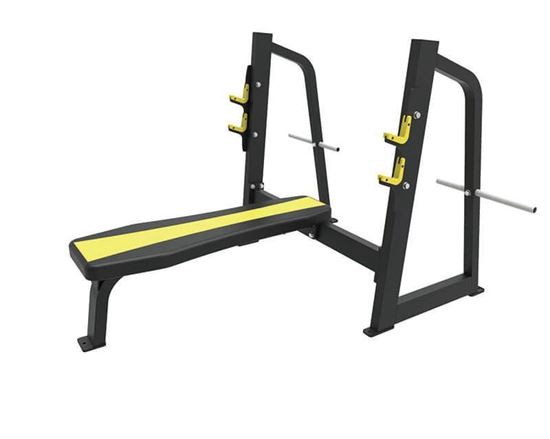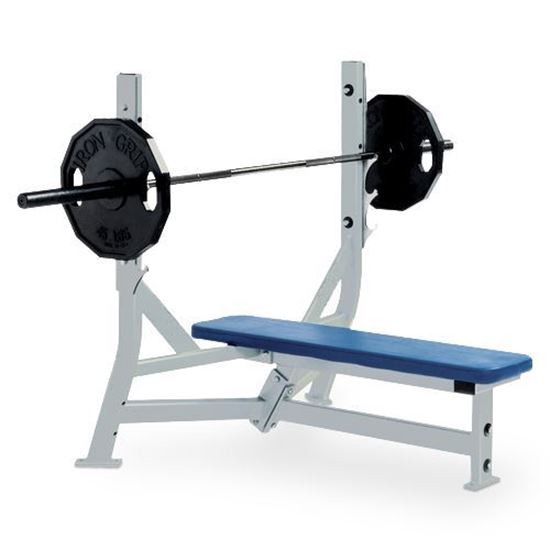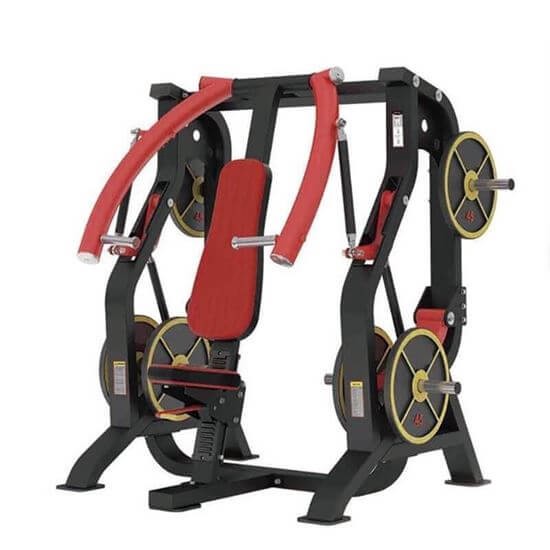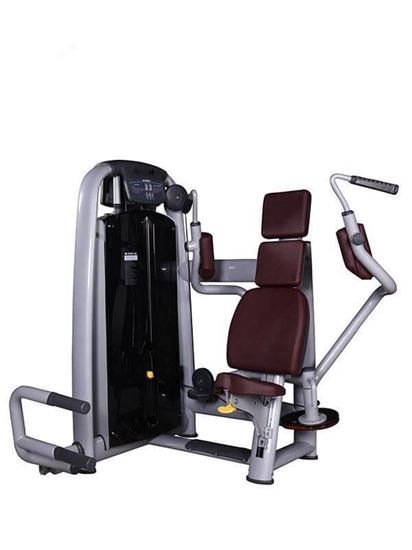How do you choose between the flat, incline, and decline bench press for your workouts?
A few of the ways an athlete typically chooses between each bench variation revolves around their sport, body composition, and strength goals. Each bench variation can be useful for everyone in the right context, regardless of their strength sport.
 https://www.fitness-china.com/olympic-flat-bench-press-aeroex-6060
https://www.fitness-china.com/olympic-flat-bench-press-aeroex-6060
Whether you?re swimming, pushing a grocery cart, or throwing a ball, having strong chest muscles is essential for everyday activities.
It?s extremely important to train your chest muscles just as you would any other muscle group. One of the most common and effective exercises for working your chest muscles is the chest press. But which chest press is the most effective, the incline or the flat bench chest press?
This article will dive into what some of the barbell bench press research is saying about using different angles to facilitate different outcomes. In this article, we?ll assess which bench variation is best for body composition goals and pressing strength. Keep in mind, most of this will come down to the reps, sets, and intensities used, but it?s still interesting to look at the research and compare it to what?s commonly used in the gym.
There?s really no right or wrong answer. It?s more a matter of preference, what your personal goals are, and what you?re trying to achieve. To maximize your results, do both types of chest presses since they both work almost all the same muscles but hit the muscle in slightly different ways.
 https://www.fitness-china.com/hammer-strength-olympic-flat-bench
https://www.fitness-china.com/hammer-strength-olympic-flat-bench
Incline bench presses
Incline bench is an alternative exercise to the flat bench that places the back of the bench at a 15 to 60-degree angle. The general consensus seems to be that an incline of 15?30 degrees will put optimal stress on the upper pec while keeping the recruitment of the front delts to a minimum.
Most incline benches that cannot be adjusted usually have a 45-degree angle. If you have an adjustable bench, the higher the back is angled, the more the front delts will be involved.
Any bench you use that is higher than a 45-degree angle works mostly anterior deltoids. Because of this, I do not consider this movement an incline bench press.
The pectoralis major muscle is comprised of a clavicular and a sternocostal head (upper and lower pec). The purpose of the incline press is to focus more of the work on the upper pecs. The main benefit in performing incline presses is to develop the upper portion of the pectoral muscles.
When the bench is set at an incline (15 to 30 degrees), you activate your shoulders more since it?s comparable to a shoulder press. Also, because of the angle of the bench, this exercise puts less stress on your rotator cuff, which is a common area for injury when using the flat bench.
However, there are some cons when performing an incline chest press. Because the incline chest press puts more stress on your upper pec, it develops this muscle group more, while the flat bench tends to build mass over the entire pec.
You?re also actively using your deltoids (shoulders) at this angle, so you don?t want to work on your deltoids the next day. You never want to overtrain your muscles, which can happen if you train the same muscle group two days in a row. Overusing any muscle can lead to injuries.
 https://www.fitness-china.com/incline-chest-press-oneup-3103
https://www.fitness-china.com/incline-chest-press-oneup-3103
Incline chest press, step by step
Lie back on an incline bench. Make sure the bench is adjusted to between 15 and 30 degrees on an incline. Anything higher than 30 degrees mainly works the anterior deltoids (shoulders). Your grip should be where your elbows make a 90-degree angle.
Using a shoulder-width grip, wrap your fingers around the bar with your palms facing away from you. Lift the bar up from the rack and hold it straight over you with your arms locked.
As you breathe in, come down slowly until the bar is an inch away from your chest. You want the bar to be in line with your upper chest the whole time. Your arms should be at a 45-degree angle and tucked into your sides.
Hold this position for one count at the bottom of this movement and, with one big exhale, push the bar back up to your starting position. Lock your arms, hold, and come down slowly.
Do 12 repetitions and then place the bar back on the rack.
Complete a total of five sets, adding weight after each set.
Flat bench presses
The flat bench press is arguably the most popular exercise in the gym. When someone finds out you lift weights, inevitably the first thing that comes out of most people?s mouths are ?how much do you bench?? Because we have a National Bench Day, there must be something to the flat bench press. It is great for building your chest up, right?
As mentioned, the pectoralis major is comprised of the upper and lower pec. When flat benching, both heads are stressed evenly, which makes this exercise best for overall pec development. The flat bench press is a much more natural fluid movement, compared to your everyday activities. However, just like the incline chest press, there are some cons.
There are plenty of articles and videos that teach you how to get the most out of the flat barbell bench press. With so much information available about this exercise, it?s obvious that the bench press is a worthwhile exercise, right?
IFBB Pro Eddie Robinson says ?I feel the flat bench press, with a wide grip, is best for overall pec development??
The flat bench is one of the ?big 3 exercises? that I feel need to be incorporated into a training program in order to be the most effective and build a balanced and muscular physique.
Flat benching requires minimal equipment and is a natural movement. This means that with a little practice, you can start adding weight to the bar and building some muscle.
 https://www.fitness-china.com/butterfly-pectoral-machine-occupied-9018
https://www.fitness-china.com/butterfly-pectoral-machine-occupied-9018
By simply changing grip width, you can put pressure on different areas of your chest which can be used dynamically in a training routine. Using dumbbells on the flat bench will give you the benefits of a barbell bench press while giving you the ability to move your arms in a more natural fashion.
As a personal trainer, I see shoulder injuries among men as the most common injuries. Common mistakes are:
not having anyone to spot them properly
not having helped to re-rack the bar
uneven grip
having a more dominant side lifting most of the weight, meaning they were probably at a tilt
As with any kind of press, you really need to warm up your chest and shoulders properly by using resistance bands and by stretching. With flat benching, you need to make sure you have full shoulder mobility and scapular stability to reduce the potential for injury.
If you find discomfort at all during the flat bench exercise, you should really consider the incline bench exercise or use dumbbells instead.
Ultimately, it?s a matter of preference and what your goals are. The flat bench press does a better job of developing your pecs. But many trainers agree that the incline press is safer on your pecs, shoulders, and rotator cuffs. With so many exercises to strengthen your chest, the chest press with either bench will be effective.
Here are some pointers to make sure you?re performing each exercise properly.
Flat bench chest press, step by step
Lay down on the flat bench so that your neck and head are supported. Your knees should be at a 90-degree angle with your feet flat on the floor. If your back comes off the bench, you might consider putting your feet on the bench instead of the floor. Position yourself underneath the bar so that the bar is in line with your chest. Place your hands slightly wider than your shoulders, with your elbows flexed at a 90-degree angle. Grasp the bar, palms facing away from you, with your fingers wrapped around it.
Exhale, squeeze your core, and push the barbell off the rack and up toward the ceiling using your pectoral muscles. Straighten your arms out in the contracted position, and squeeze your chest.
Inhale and bring the barbell down slowly to your chest, again about an inch away. It should take you twice as long to bring the barbell down as it does to push it up.
Explode back up to your starting position using your pectoral muscles. Do 12 repetitions and then add more weight for your next set.
Perform five sets.
Safety precaution
If you?re using dumbbells, it?s important that you don?t drop the dumbbells down to your side when you?re done using them. This is dangerous to your rotator cuff and to people around you. If you don?t have a spotter to take the weights away, rest the dumbbells on your chest and do a crunch to lift yourself up to a seated position. Then lower the dumbbells to your thighs and then down to the floor.
If you?re new at this exercise, please use a spotter. If no spotter is available, then be cautious with the amount of weight you use.
Chest Routine Suggestions
If you?ve never incorporated an incline bench press into your routine, I have a few tips to add in some incline work to your routine.
If you flat bench but always seem to have hurt shoulders afterward:
Test the waters with incline barbell benching. The incline is going to help put your shoulders in a better, stronger and more protected position.
Start light and do the same volume you normally do on the flat bench, whether it is 3 sets of 8 reps, 5 sets of 5 reps, or 10 sets of 10 reps. Skip flat benching for a while to see how your shoulders react to the incline, and if shoulder pain subsides.
If you find the pain subsides but you are missing flat bench, try doing a dumbbell flat bench press. Dumbbell bench pressing will let your arms move in a more natural pattern and you will still hit the lower and upper pec evenly without the pain.
If you like flat barbell bench pressing and want to add in some incline spice:
Test the waters and see if you prefer barbell or dumbbell incline bench pressing.
Adding in dumbbell incline bench pressing after your barbell flat benching will give your upper pecs a great workout.
Since you?ve fatigued your upper and lower pec while barbell benching, there is no need to do a huge volume of incline benching to get the added benefit.
If you prefer barbell incline benching, that is okay. Doing exercises effectively and safely is the name of the game, so if you feel more comfortable with a barbell in your hands, run with it.
If you want to switch up your chest routine all together:
If you like everything about your current routine but would like to switch up your chest routine, I have a suggestion for you.
3 sets of 8: Decline Barbell Bench
3 sets of 8: Incline Dumbbell Bench
3 sets of 12: Incline Dumbbell Flyes
3 sets of 12: Pec Dec
Switching your current chest routine for this will give your muscles a wakeup call and help you develop the chest you?ve always wanted.
The flat bench will be your best bet for improving bench press strength as a whole for two reasons. First, it?s the most specific to the goal at hand, which is improving the bench. This is where sports specificity kicks in and is one of the main reasons a powerlifter practices the flat bench most often. Practice and reps of the same movement will be the best for producing results in that movement.
Second, the body can handle more weight on the flat bench and has relatively equal muscle activation. In the second study, authors noted that 6-RM bench press strength decreased roughly 25% in an athlete?s incline press and around 18% in the decline. If you?re able to handle more weight, then there will be a higher stimulus for your goal of strength in the press. Plus, this angle makes it slightly easier to add in tools like accommodated resistance.
But don?t count out the incline and decline just yet. These movements can be useful when working through sticking points. For example, if you?re having issues finishing the lockout, then an incline press may be useful to strengthen the muscles like the anterior deltoids, along with the use of a wide grip for issues of the chest.
Conclusion
So is incline bench better than flat bench for muscle building? Flat bench places an even amount of stress on the lower and upper pec while also putting your shoulders in a vulnerable position. Incline bench puts more stress on the upper pec and front delts and has a steeper learning curve when it comes to proper form.
When deciding which exercise to use to build chest mass, weigh the pros and cons. Take a look in the mirror and see where you need development. There are IFBB Pros that tell you if you have a laggy upper chest, you should incorporate incline benching. There are also many people who build a great chest using the only flat bench.
As these are two exercises are very similar in execution they have a few significant differences in effect. Common sense would tell you that the flat version stresses the middle and lower portions of the pecs and the incline would stress the upper area. Well, the truth is that they do stress their respective areas of the chest; however, they still both stress the entire area to some degree. When done properly and the shoulders are set as described both will do their jobs in packing on the mass to the entire chest.
The incline bench barbell press does seem to stretch the chest more requiring a longer range of motion. This is usually why less weight is needed and bad form is sometimes used when ego creeps in. In many cases, the incline barbell press is rarely used with any regularity by most gym-goers with the flat bench version always included in most programs. Weak upper pecs and a larger, stronger middle and lower chest seem to be the norm in most gyms.
Be sure to use both versions in your program even starting with the incline press first in your routine. Starting your next chest program with a focus on upper pec work will slowly but surely shore-up your weakness and balance out your chest for a fully proportioned upper body.
Remember that both dumbbells and barbells add different dynamics to your training; ones you might not have thought about. Barbells are tried and true muscle builders. They allow you to really stack on the weight, work stabilizer muscles and use the bar to help balance and keep your press even.
Dumbbells, on the other hand, are a completely different monster. You have to use even more stabilizer muscle strength to keep the dumbbells positioned correctly while pressing. The more stabilizer muscles being used generally means the more muscle that can be built. Greater stabilizer muscle inclusion also means there is a greater chance for injury, especially if you try to do more than you are ready for.
Your chest programming should be determined by how fast your body recovers and builds muscle. It?s important to choose your exercises wisely. The amount of incline bench, grip width variety, or barbell and dumbbell variations can make a difference in your training and results.
There are multiple factors that should be taken into context when programming for chest size and strength. All three bench angles can be useful tools for pursuing your goals and have all been suggested to be effective in various settings.


